Business Management Report: Innovation and Technology on Business
VerifiedAdded on 2020/02/19
|71
|14572
|35
Report
AI Summary
This report investigates the financial impact of innovation and technology usage on business management, focusing on Pfizer as a case study. The research explores various aspects, including strategy innovation, business innovation (revenue, enterprise, and industry models), and technology innovation. It examines the impact of technological changes on business management, such as identifying accurate solutions, attaining competitive advantages, satisfying stakeholders, formulating new product lines, and increasing productivity. The methodology includes primary data collection, quantitative and qualitative data analysis, and regression analysis to test the hypothesis that innovation and technological changes significantly impact business economy. The report analyzes survey data from Pfizer employees and managers, providing descriptive and interview analysis. Key findings are linked to research objectives, and recommendations are provided for better adoption of innovation and technology in business management, aiming to enhance financial growth and competitive advantage.
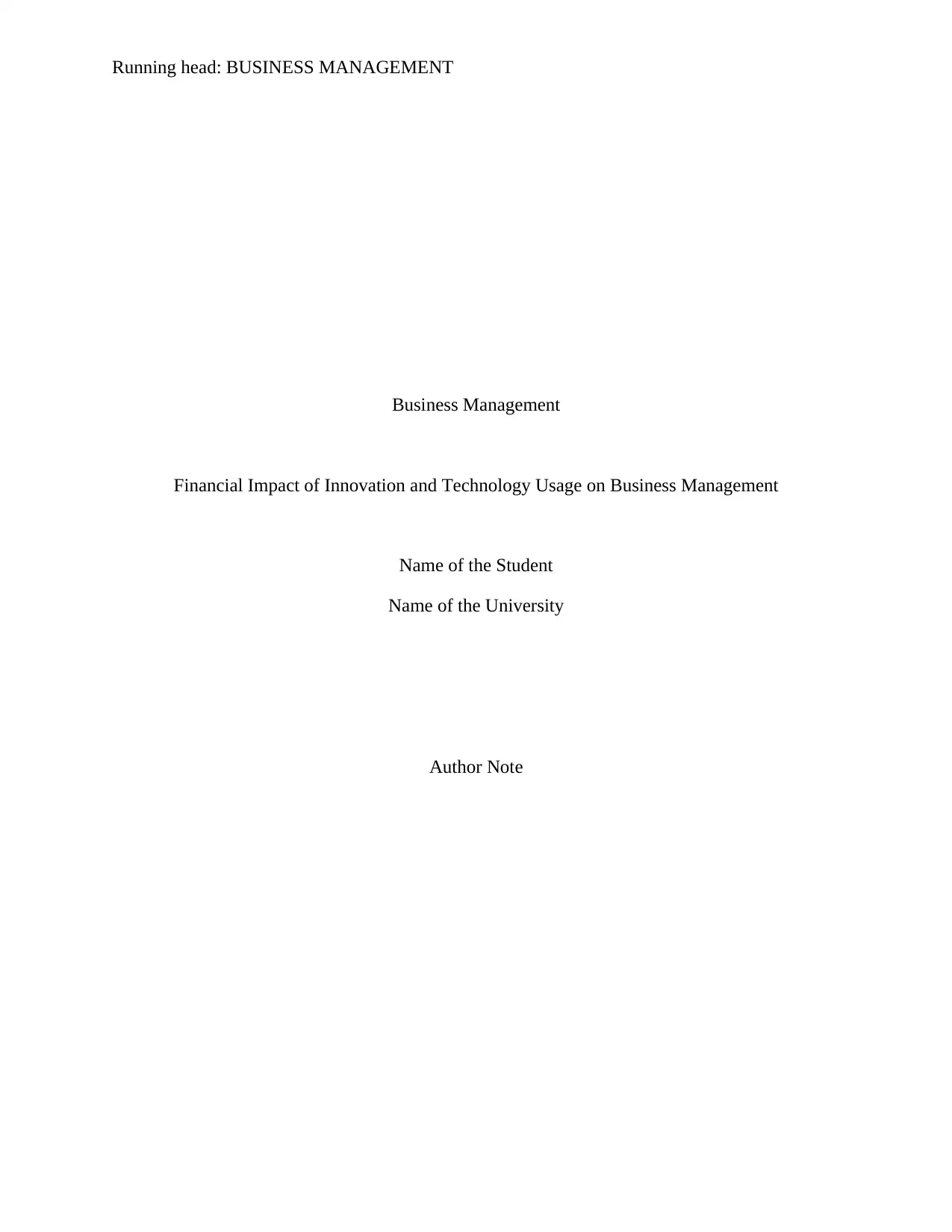
Running head: BUSINESS MANAGEMENT
Business Management
Financial Impact of Innovation and Technology Usage on Business Management
Name of the Student
Name of the University
Author Note
Business Management
Financial Impact of Innovation and Technology Usage on Business Management
Name of the Student
Name of the University
Author Note
Paraphrase This Document
Need a fresh take? Get an instant paraphrase of this document with our AI Paraphraser
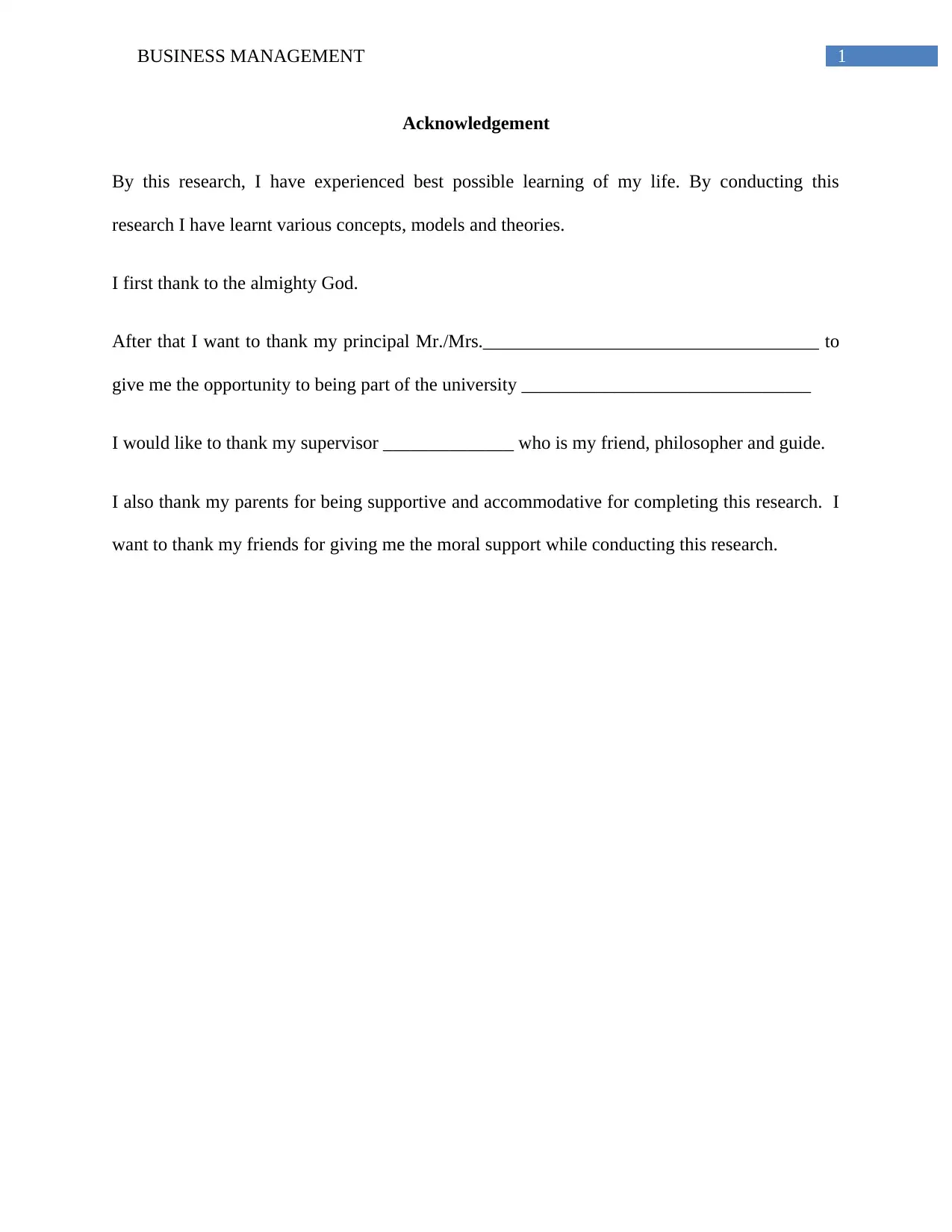
1BUSINESS MANAGEMENT
Acknowledgement
By this research, I have experienced best possible learning of my life. By conducting this
research I have learnt various concepts, models and theories.
I first thank to the almighty God.
After that I want to thank my principal Mr./Mrs.____________________________________ to
give me the opportunity to being part of the university _______________________________
I would like to thank my supervisor ______________ who is my friend, philosopher and guide.
I also thank my parents for being supportive and accommodative for completing this research. I
want to thank my friends for giving me the moral support while conducting this research.
Acknowledgement
By this research, I have experienced best possible learning of my life. By conducting this
research I have learnt various concepts, models and theories.
I first thank to the almighty God.
After that I want to thank my principal Mr./Mrs.____________________________________ to
give me the opportunity to being part of the university _______________________________
I would like to thank my supervisor ______________ who is my friend, philosopher and guide.
I also thank my parents for being supportive and accommodative for completing this research. I
want to thank my friends for giving me the moral support while conducting this research.
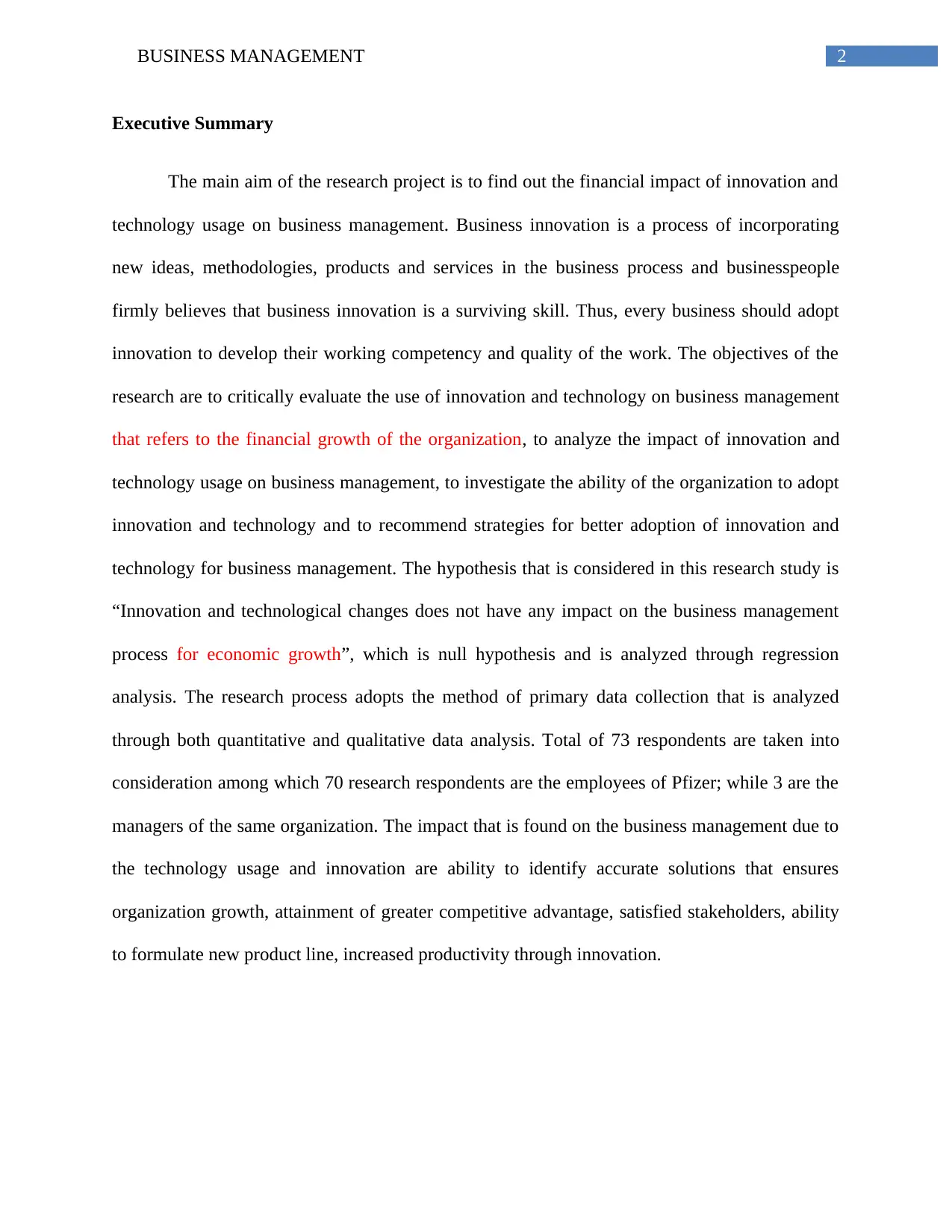
2BUSINESS MANAGEMENT
Executive Summary
The main aim of the research project is to find out the financial impact of innovation and
technology usage on business management. Business innovation is a process of incorporating
new ideas, methodologies, products and services in the business process and businesspeople
firmly believes that business innovation is a surviving skill. Thus, every business should adopt
innovation to develop their working competency and quality of the work. The objectives of the
research are to critically evaluate the use of innovation and technology on business management
that refers to the financial growth of the organization, to analyze the impact of innovation and
technology usage on business management, to investigate the ability of the organization to adopt
innovation and technology and to recommend strategies for better adoption of innovation and
technology for business management. The hypothesis that is considered in this research study is
“Innovation and technological changes does not have any impact on the business management
process for economic growth”, which is null hypothesis and is analyzed through regression
analysis. The research process adopts the method of primary data collection that is analyzed
through both quantitative and qualitative data analysis. Total of 73 respondents are taken into
consideration among which 70 research respondents are the employees of Pfizer; while 3 are the
managers of the same organization. The impact that is found on the business management due to
the technology usage and innovation are ability to identify accurate solutions that ensures
organization growth, attainment of greater competitive advantage, satisfied stakeholders, ability
to formulate new product line, increased productivity through innovation.
Executive Summary
The main aim of the research project is to find out the financial impact of innovation and
technology usage on business management. Business innovation is a process of incorporating
new ideas, methodologies, products and services in the business process and businesspeople
firmly believes that business innovation is a surviving skill. Thus, every business should adopt
innovation to develop their working competency and quality of the work. The objectives of the
research are to critically evaluate the use of innovation and technology on business management
that refers to the financial growth of the organization, to analyze the impact of innovation and
technology usage on business management, to investigate the ability of the organization to adopt
innovation and technology and to recommend strategies for better adoption of innovation and
technology for business management. The hypothesis that is considered in this research study is
“Innovation and technological changes does not have any impact on the business management
process for economic growth”, which is null hypothesis and is analyzed through regression
analysis. The research process adopts the method of primary data collection that is analyzed
through both quantitative and qualitative data analysis. Total of 73 respondents are taken into
consideration among which 70 research respondents are the employees of Pfizer; while 3 are the
managers of the same organization. The impact that is found on the business management due to
the technology usage and innovation are ability to identify accurate solutions that ensures
organization growth, attainment of greater competitive advantage, satisfied stakeholders, ability
to formulate new product line, increased productivity through innovation.
⊘ This is a preview!⊘
Do you want full access?
Subscribe today to unlock all pages.

Trusted by 1+ million students worldwide
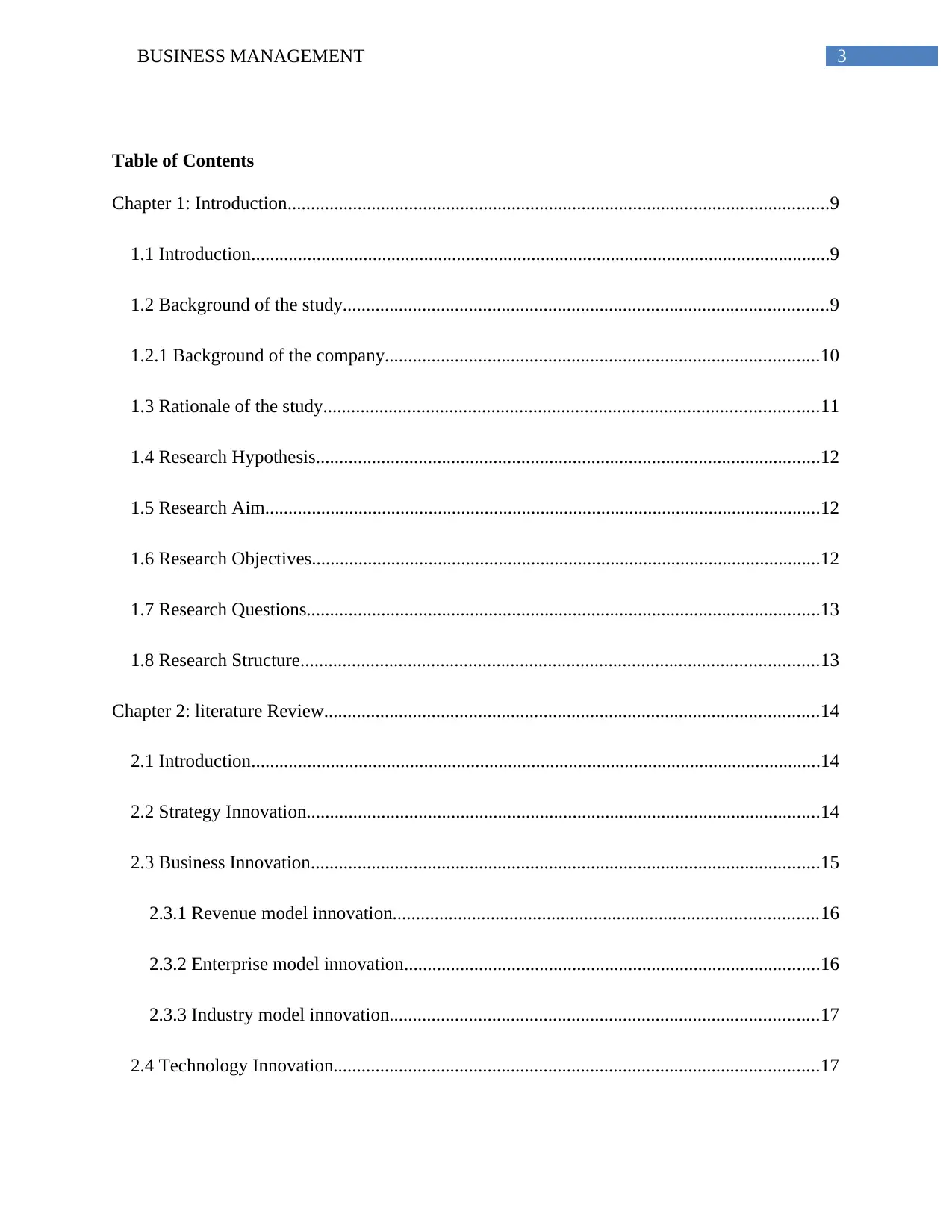
3BUSINESS MANAGEMENT
Table of Contents
Chapter 1: Introduction....................................................................................................................9
1.1 Introduction............................................................................................................................9
1.2 Background of the study........................................................................................................9
1.2.1 Background of the company.............................................................................................10
1.3 Rationale of the study..........................................................................................................11
1.4 Research Hypothesis............................................................................................................12
1.5 Research Aim.......................................................................................................................12
1.6 Research Objectives.............................................................................................................12
1.7 Research Questions..............................................................................................................13
1.8 Research Structure...............................................................................................................13
Chapter 2: literature Review..........................................................................................................14
2.1 Introduction..........................................................................................................................14
2.2 Strategy Innovation..............................................................................................................14
2.3 Business Innovation.............................................................................................................15
2.3.1 Revenue model innovation...........................................................................................16
2.3.2 Enterprise model innovation.........................................................................................16
2.3.3 Industry model innovation............................................................................................17
2.4 Technology Innovation........................................................................................................17
Table of Contents
Chapter 1: Introduction....................................................................................................................9
1.1 Introduction............................................................................................................................9
1.2 Background of the study........................................................................................................9
1.2.1 Background of the company.............................................................................................10
1.3 Rationale of the study..........................................................................................................11
1.4 Research Hypothesis............................................................................................................12
1.5 Research Aim.......................................................................................................................12
1.6 Research Objectives.............................................................................................................12
1.7 Research Questions..............................................................................................................13
1.8 Research Structure...............................................................................................................13
Chapter 2: literature Review..........................................................................................................14
2.1 Introduction..........................................................................................................................14
2.2 Strategy Innovation..............................................................................................................14
2.3 Business Innovation.............................................................................................................15
2.3.1 Revenue model innovation...........................................................................................16
2.3.2 Enterprise model innovation.........................................................................................16
2.3.3 Industry model innovation............................................................................................17
2.4 Technology Innovation........................................................................................................17
Paraphrase This Document
Need a fresh take? Get an instant paraphrase of this document with our AI Paraphraser
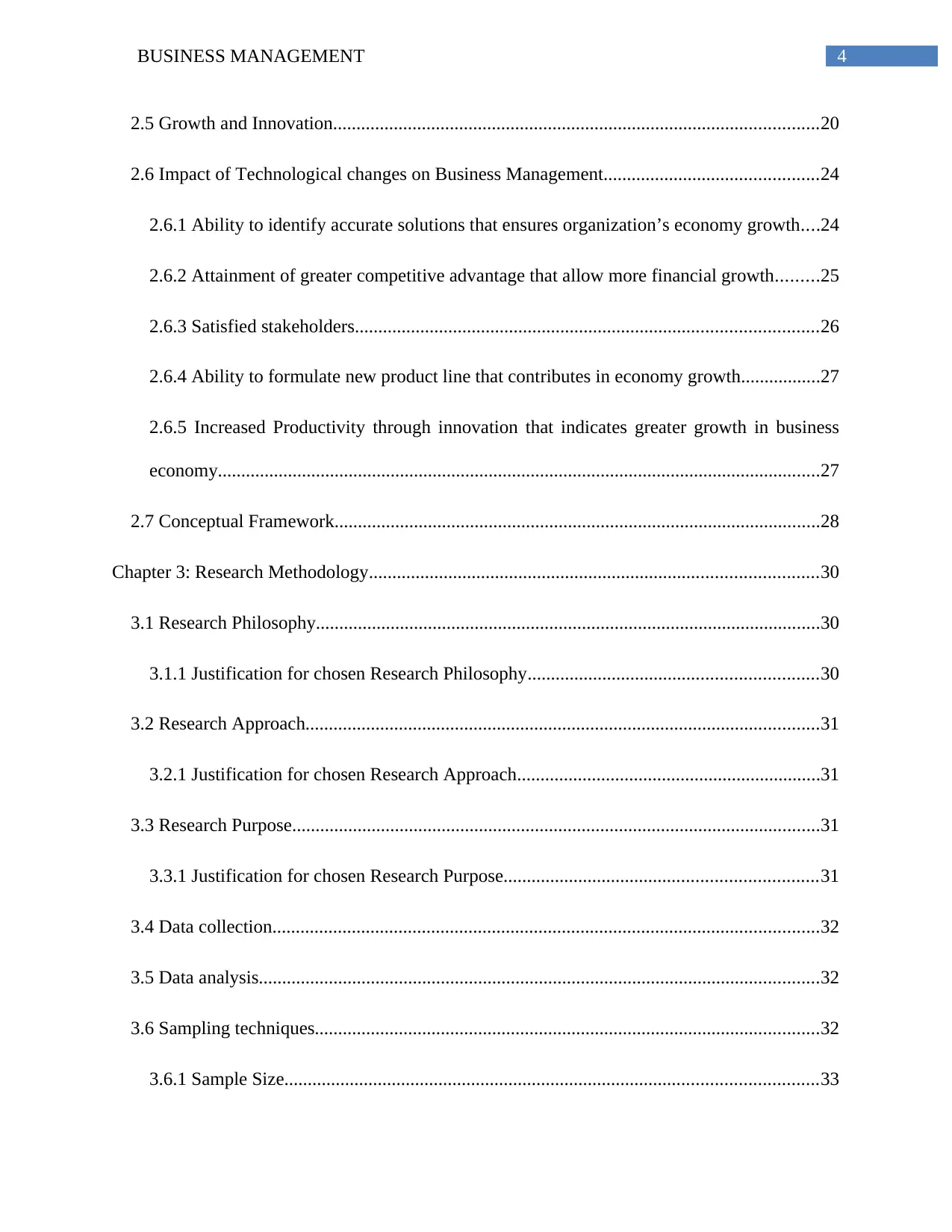
4BUSINESS MANAGEMENT
2.5 Growth and Innovation........................................................................................................20
2.6 Impact of Technological changes on Business Management..............................................24
2.6.1 Ability to identify accurate solutions that ensures organization’s economy growth....24
2.6.2 Attainment of greater competitive advantage that allow more financial growth.........25
2.6.3 Satisfied stakeholders...................................................................................................26
2.6.4 Ability to formulate new product line that contributes in economy growth.................27
2.6.5 Increased Productivity through innovation that indicates greater growth in business
economy.................................................................................................................................27
2.7 Conceptual Framework........................................................................................................28
Chapter 3: Research Methodology................................................................................................30
3.1 Research Philosophy............................................................................................................30
3.1.1 Justification for chosen Research Philosophy..............................................................30
3.2 Research Approach..............................................................................................................31
3.2.1 Justification for chosen Research Approach.................................................................31
3.3 Research Purpose.................................................................................................................31
3.3.1 Justification for chosen Research Purpose...................................................................31
3.4 Data collection.....................................................................................................................32
3.5 Data analysis........................................................................................................................32
3.6 Sampling techniques............................................................................................................32
3.6.1 Sample Size..................................................................................................................33
2.5 Growth and Innovation........................................................................................................20
2.6 Impact of Technological changes on Business Management..............................................24
2.6.1 Ability to identify accurate solutions that ensures organization’s economy growth....24
2.6.2 Attainment of greater competitive advantage that allow more financial growth.........25
2.6.3 Satisfied stakeholders...................................................................................................26
2.6.4 Ability to formulate new product line that contributes in economy growth.................27
2.6.5 Increased Productivity through innovation that indicates greater growth in business
economy.................................................................................................................................27
2.7 Conceptual Framework........................................................................................................28
Chapter 3: Research Methodology................................................................................................30
3.1 Research Philosophy............................................................................................................30
3.1.1 Justification for chosen Research Philosophy..............................................................30
3.2 Research Approach..............................................................................................................31
3.2.1 Justification for chosen Research Approach.................................................................31
3.3 Research Purpose.................................................................................................................31
3.3.1 Justification for chosen Research Purpose...................................................................31
3.4 Data collection.....................................................................................................................32
3.5 Data analysis........................................................................................................................32
3.6 Sampling techniques............................................................................................................32
3.6.1 Sample Size..................................................................................................................33
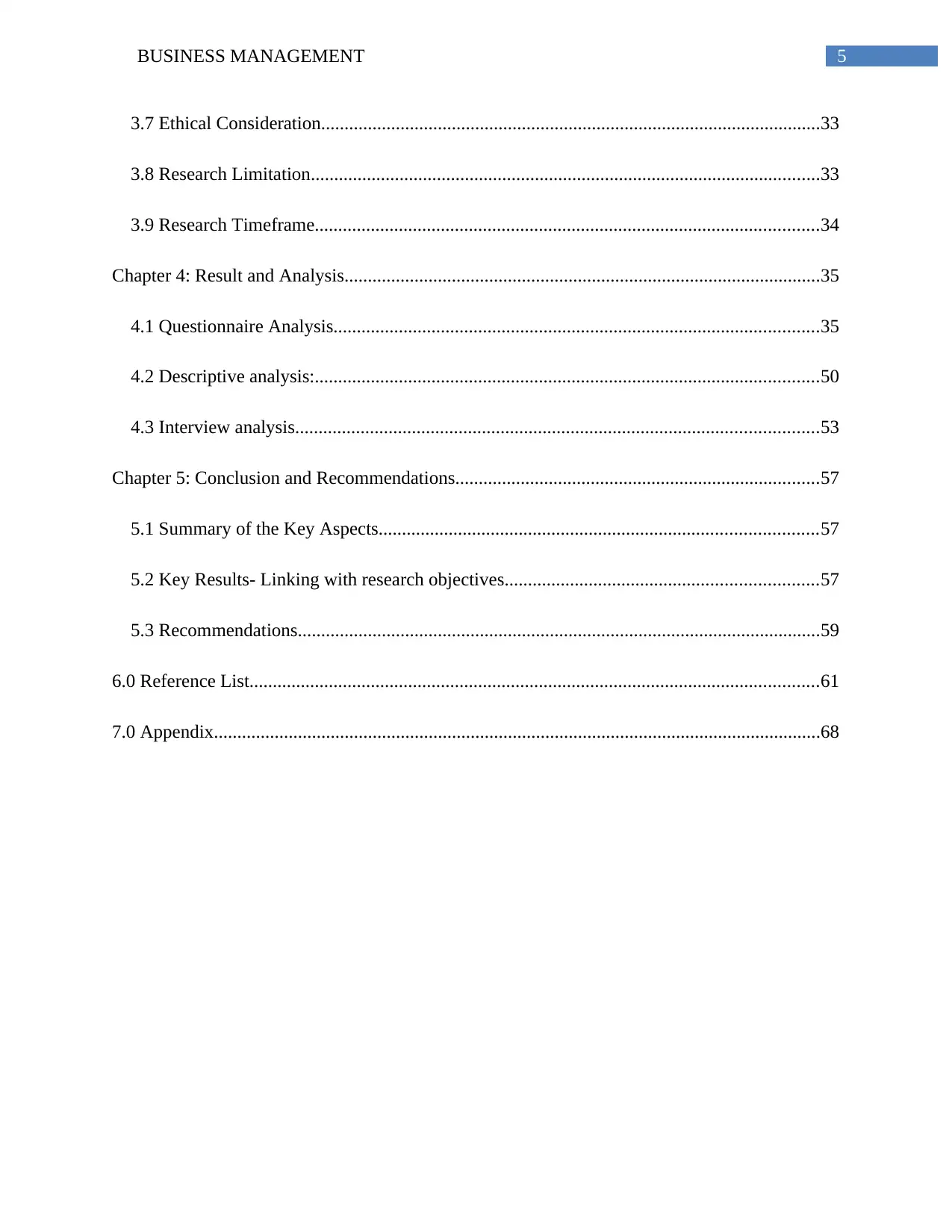
5BUSINESS MANAGEMENT
3.7 Ethical Consideration...........................................................................................................33
3.8 Research Limitation.............................................................................................................33
3.9 Research Timeframe............................................................................................................34
Chapter 4: Result and Analysis......................................................................................................35
4.1 Questionnaire Analysis........................................................................................................35
4.2 Descriptive analysis:............................................................................................................50
4.3 Interview analysis................................................................................................................53
Chapter 5: Conclusion and Recommendations..............................................................................57
5.1 Summary of the Key Aspects..............................................................................................57
5.2 Key Results- Linking with research objectives...................................................................57
5.3 Recommendations................................................................................................................59
6.0 Reference List..........................................................................................................................61
7.0 Appendix..................................................................................................................................68
3.7 Ethical Consideration...........................................................................................................33
3.8 Research Limitation.............................................................................................................33
3.9 Research Timeframe............................................................................................................34
Chapter 4: Result and Analysis......................................................................................................35
4.1 Questionnaire Analysis........................................................................................................35
4.2 Descriptive analysis:............................................................................................................50
4.3 Interview analysis................................................................................................................53
Chapter 5: Conclusion and Recommendations..............................................................................57
5.1 Summary of the Key Aspects..............................................................................................57
5.2 Key Results- Linking with research objectives...................................................................57
5.3 Recommendations................................................................................................................59
6.0 Reference List..........................................................................................................................61
7.0 Appendix..................................................................................................................................68
⊘ This is a preview!⊘
Do you want full access?
Subscribe today to unlock all pages.

Trusted by 1+ million students worldwide
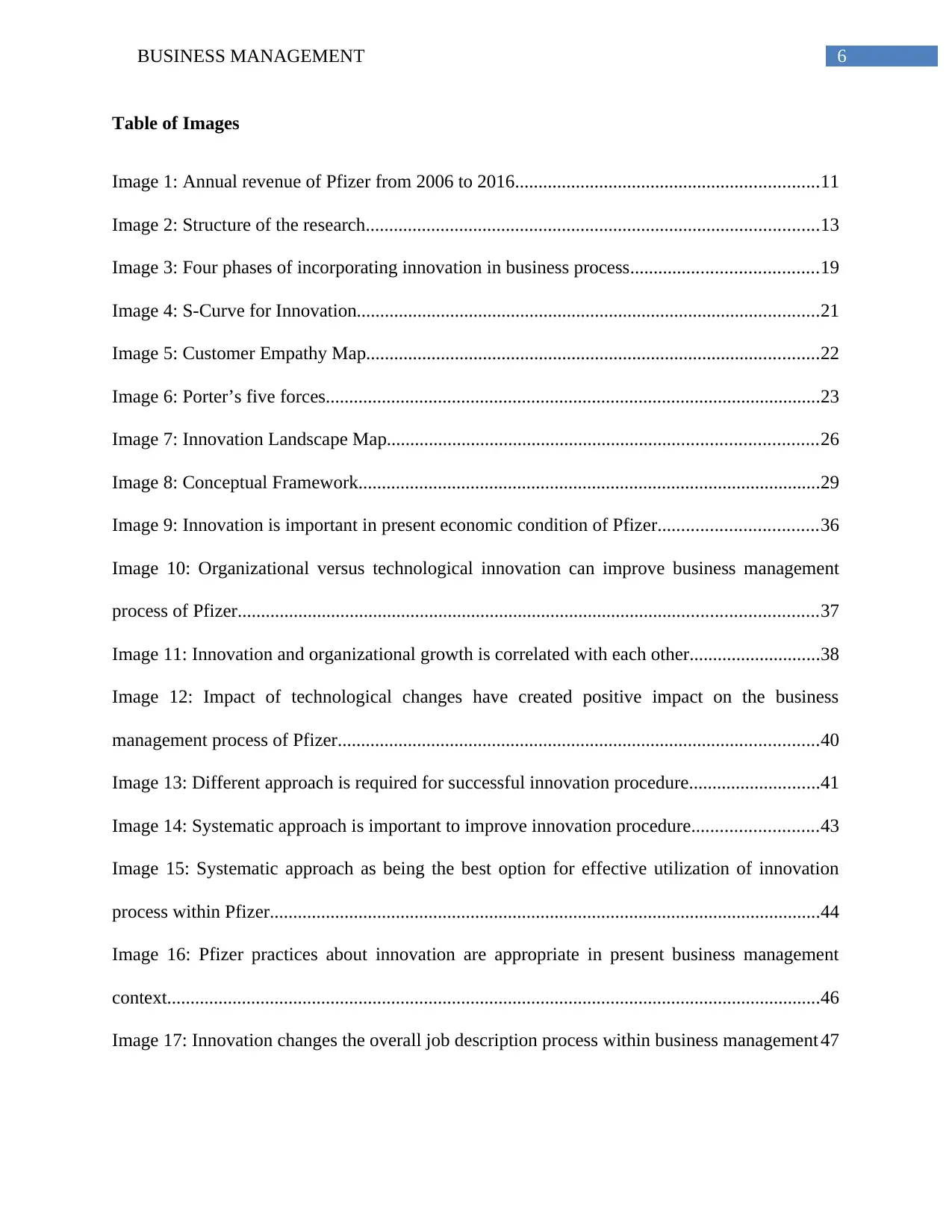
6BUSINESS MANAGEMENT
Table of Images
Image 1: Annual revenue of Pfizer from 2006 to 2016.................................................................11
Image 2: Structure of the research.................................................................................................13
Image 3: Four phases of incorporating innovation in business process........................................19
Image 4: S-Curve for Innovation...................................................................................................21
Image 5: Customer Empathy Map.................................................................................................22
Image 6: Porter’s five forces..........................................................................................................23
Image 7: Innovation Landscape Map............................................................................................26
Image 8: Conceptual Framework...................................................................................................29
Image 9: Innovation is important in present economic condition of Pfizer..................................36
Image 10: Organizational versus technological innovation can improve business management
process of Pfizer............................................................................................................................37
Image 11: Innovation and organizational growth is correlated with each other............................38
Image 12: Impact of technological changes have created positive impact on the business
management process of Pfizer.......................................................................................................40
Image 13: Different approach is required for successful innovation procedure............................41
Image 14: Systematic approach is important to improve innovation procedure...........................43
Image 15: Systematic approach as being the best option for effective utilization of innovation
process within Pfizer......................................................................................................................44
Image 16: Pfizer practices about innovation are appropriate in present business management
context............................................................................................................................................46
Image 17: Innovation changes the overall job description process within business management 47
Table of Images
Image 1: Annual revenue of Pfizer from 2006 to 2016.................................................................11
Image 2: Structure of the research.................................................................................................13
Image 3: Four phases of incorporating innovation in business process........................................19
Image 4: S-Curve for Innovation...................................................................................................21
Image 5: Customer Empathy Map.................................................................................................22
Image 6: Porter’s five forces..........................................................................................................23
Image 7: Innovation Landscape Map............................................................................................26
Image 8: Conceptual Framework...................................................................................................29
Image 9: Innovation is important in present economic condition of Pfizer..................................36
Image 10: Organizational versus technological innovation can improve business management
process of Pfizer............................................................................................................................37
Image 11: Innovation and organizational growth is correlated with each other............................38
Image 12: Impact of technological changes have created positive impact on the business
management process of Pfizer.......................................................................................................40
Image 13: Different approach is required for successful innovation procedure............................41
Image 14: Systematic approach is important to improve innovation procedure...........................43
Image 15: Systematic approach as being the best option for effective utilization of innovation
process within Pfizer......................................................................................................................44
Image 16: Pfizer practices about innovation are appropriate in present business management
context............................................................................................................................................46
Image 17: Innovation changes the overall job description process within business management 47
Paraphrase This Document
Need a fresh take? Get an instant paraphrase of this document with our AI Paraphraser
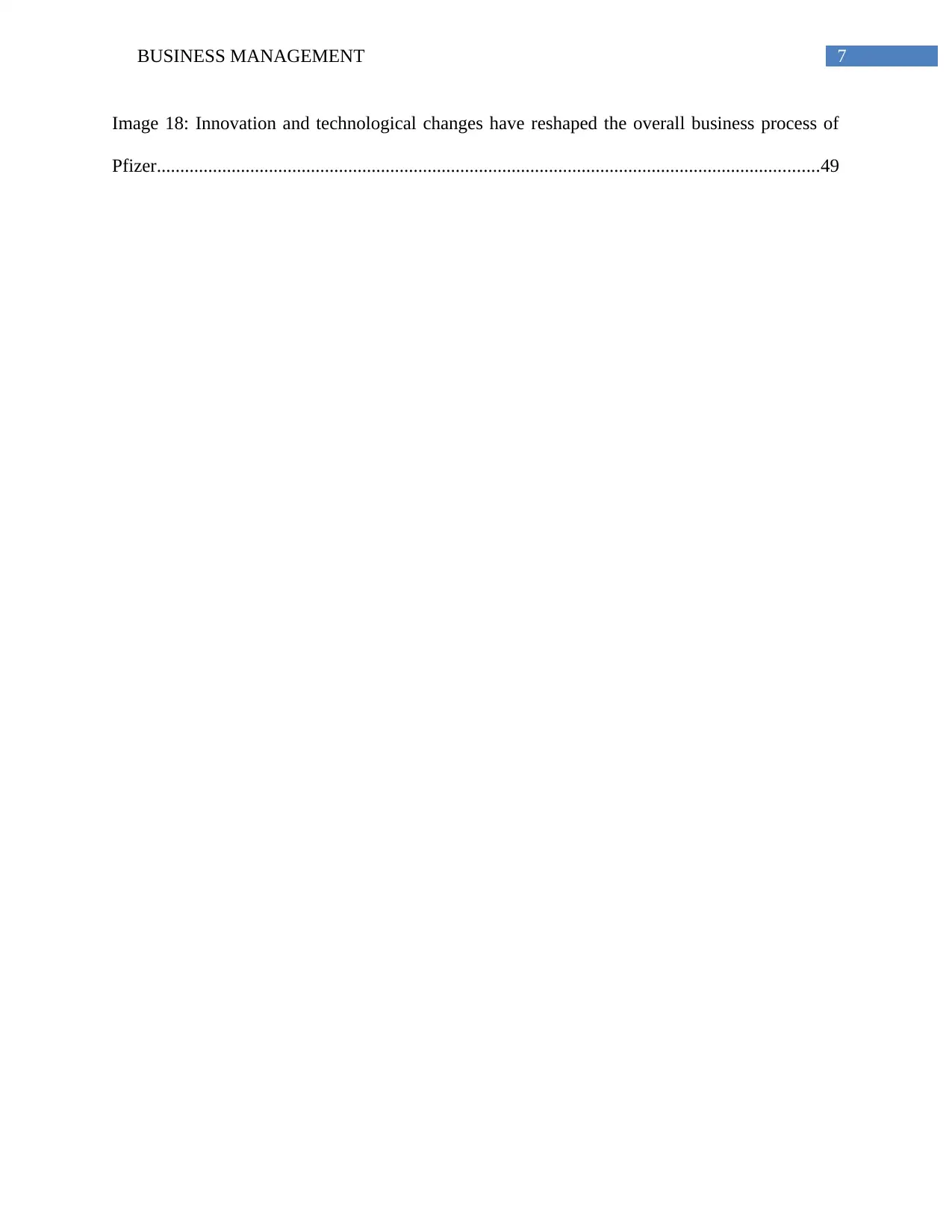
7BUSINESS MANAGEMENT
Image 18: Innovation and technological changes have reshaped the overall business process of
Pfizer..............................................................................................................................................49
Image 18: Innovation and technological changes have reshaped the overall business process of
Pfizer..............................................................................................................................................49
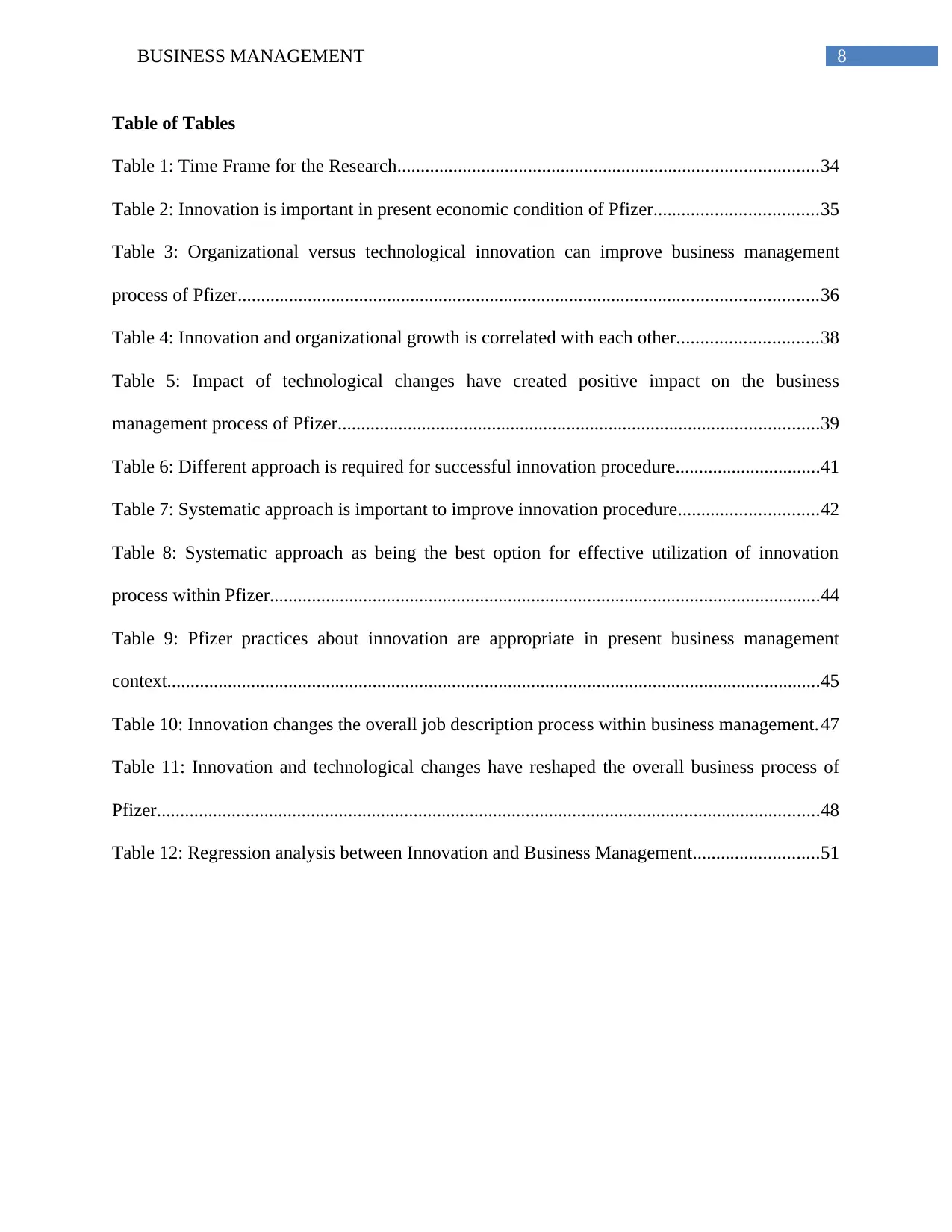
8BUSINESS MANAGEMENT
Table of Tables
Table 1: Time Frame for the Research..........................................................................................34
Table 2: Innovation is important in present economic condition of Pfizer...................................35
Table 3: Organizational versus technological innovation can improve business management
process of Pfizer............................................................................................................................36
Table 4: Innovation and organizational growth is correlated with each other..............................38
Table 5: Impact of technological changes have created positive impact on the business
management process of Pfizer.......................................................................................................39
Table 6: Different approach is required for successful innovation procedure...............................41
Table 7: Systematic approach is important to improve innovation procedure..............................42
Table 8: Systematic approach as being the best option for effective utilization of innovation
process within Pfizer......................................................................................................................44
Table 9: Pfizer practices about innovation are appropriate in present business management
context............................................................................................................................................45
Table 10: Innovation changes the overall job description process within business management.47
Table 11: Innovation and technological changes have reshaped the overall business process of
Pfizer..............................................................................................................................................48
Table 12: Regression analysis between Innovation and Business Management...........................51
Table of Tables
Table 1: Time Frame for the Research..........................................................................................34
Table 2: Innovation is important in present economic condition of Pfizer...................................35
Table 3: Organizational versus technological innovation can improve business management
process of Pfizer............................................................................................................................36
Table 4: Innovation and organizational growth is correlated with each other..............................38
Table 5: Impact of technological changes have created positive impact on the business
management process of Pfizer.......................................................................................................39
Table 6: Different approach is required for successful innovation procedure...............................41
Table 7: Systematic approach is important to improve innovation procedure..............................42
Table 8: Systematic approach as being the best option for effective utilization of innovation
process within Pfizer......................................................................................................................44
Table 9: Pfizer practices about innovation are appropriate in present business management
context............................................................................................................................................45
Table 10: Innovation changes the overall job description process within business management.47
Table 11: Innovation and technological changes have reshaped the overall business process of
Pfizer..............................................................................................................................................48
Table 12: Regression analysis between Innovation and Business Management...........................51
⊘ This is a preview!⊘
Do you want full access?
Subscribe today to unlock all pages.

Trusted by 1+ million students worldwide
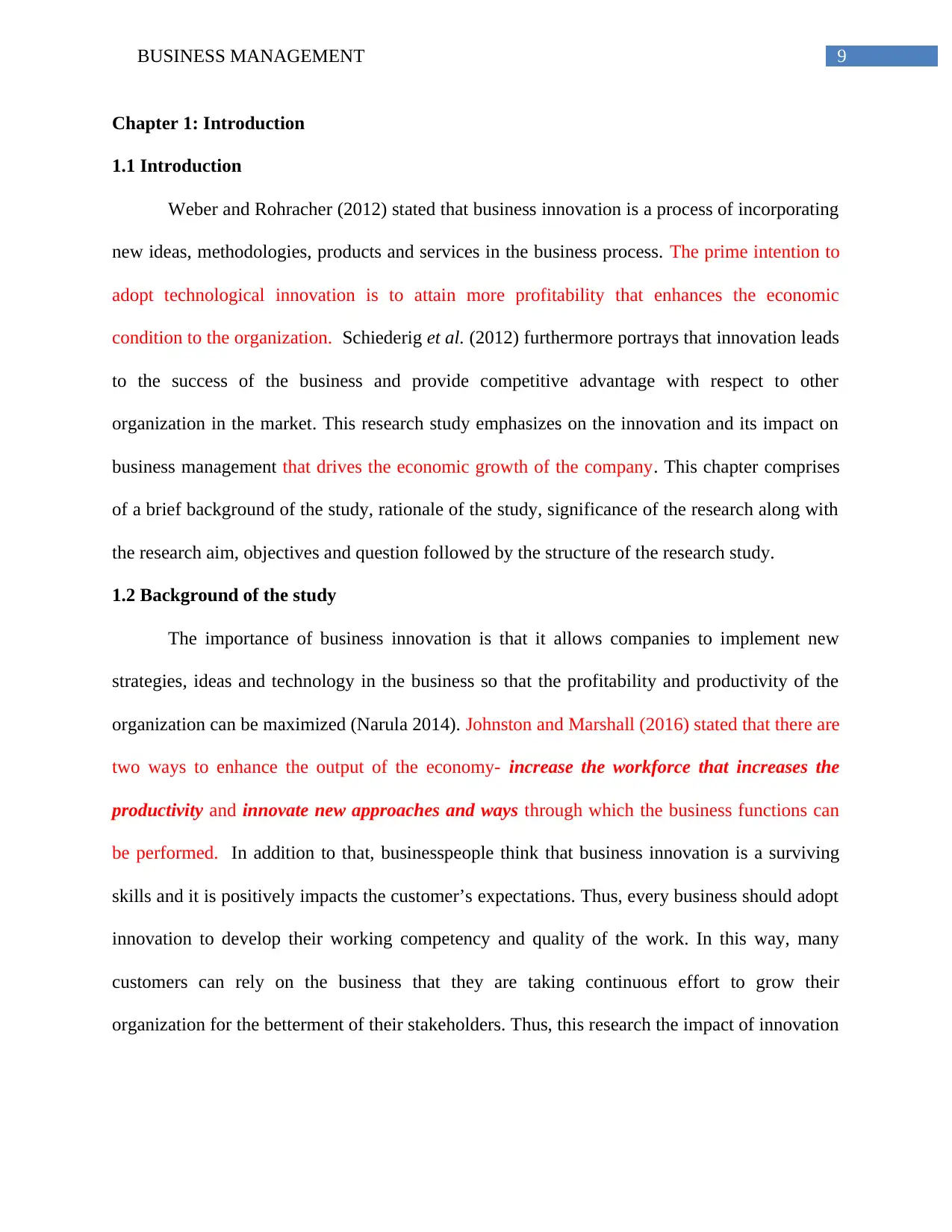
9BUSINESS MANAGEMENT
Chapter 1: Introduction
1.1 Introduction
Weber and Rohracher (2012) stated that business innovation is a process of incorporating
new ideas, methodologies, products and services in the business process. The prime intention to
adopt technological innovation is to attain more profitability that enhances the economic
condition to the organization. Schiederig et al. (2012) furthermore portrays that innovation leads
to the success of the business and provide competitive advantage with respect to other
organization in the market. This research study emphasizes on the innovation and its impact on
business management that drives the economic growth of the company. This chapter comprises
of a brief background of the study, rationale of the study, significance of the research along with
the research aim, objectives and question followed by the structure of the research study.
1.2 Background of the study
The importance of business innovation is that it allows companies to implement new
strategies, ideas and technology in the business so that the profitability and productivity of the
organization can be maximized (Narula 2014). Johnston and Marshall (2016) stated that there are
two ways to enhance the output of the economy- increase the workforce that increases the
productivity and innovate new approaches and ways through which the business functions can
be performed. In addition to that, businesspeople think that business innovation is a surviving
skills and it is positively impacts the customer’s expectations. Thus, every business should adopt
innovation to develop their working competency and quality of the work. In this way, many
customers can rely on the business that they are taking continuous effort to grow their
organization for the betterment of their stakeholders. Thus, this research the impact of innovation
Chapter 1: Introduction
1.1 Introduction
Weber and Rohracher (2012) stated that business innovation is a process of incorporating
new ideas, methodologies, products and services in the business process. The prime intention to
adopt technological innovation is to attain more profitability that enhances the economic
condition to the organization. Schiederig et al. (2012) furthermore portrays that innovation leads
to the success of the business and provide competitive advantage with respect to other
organization in the market. This research study emphasizes on the innovation and its impact on
business management that drives the economic growth of the company. This chapter comprises
of a brief background of the study, rationale of the study, significance of the research along with
the research aim, objectives and question followed by the structure of the research study.
1.2 Background of the study
The importance of business innovation is that it allows companies to implement new
strategies, ideas and technology in the business so that the profitability and productivity of the
organization can be maximized (Narula 2014). Johnston and Marshall (2016) stated that there are
two ways to enhance the output of the economy- increase the workforce that increases the
productivity and innovate new approaches and ways through which the business functions can
be performed. In addition to that, businesspeople think that business innovation is a surviving
skills and it is positively impacts the customer’s expectations. Thus, every business should adopt
innovation to develop their working competency and quality of the work. In this way, many
customers can rely on the business that they are taking continuous effort to grow their
organization for the betterment of their stakeholders. Thus, this research the impact of innovation
Paraphrase This Document
Need a fresh take? Get an instant paraphrase of this document with our AI Paraphraser
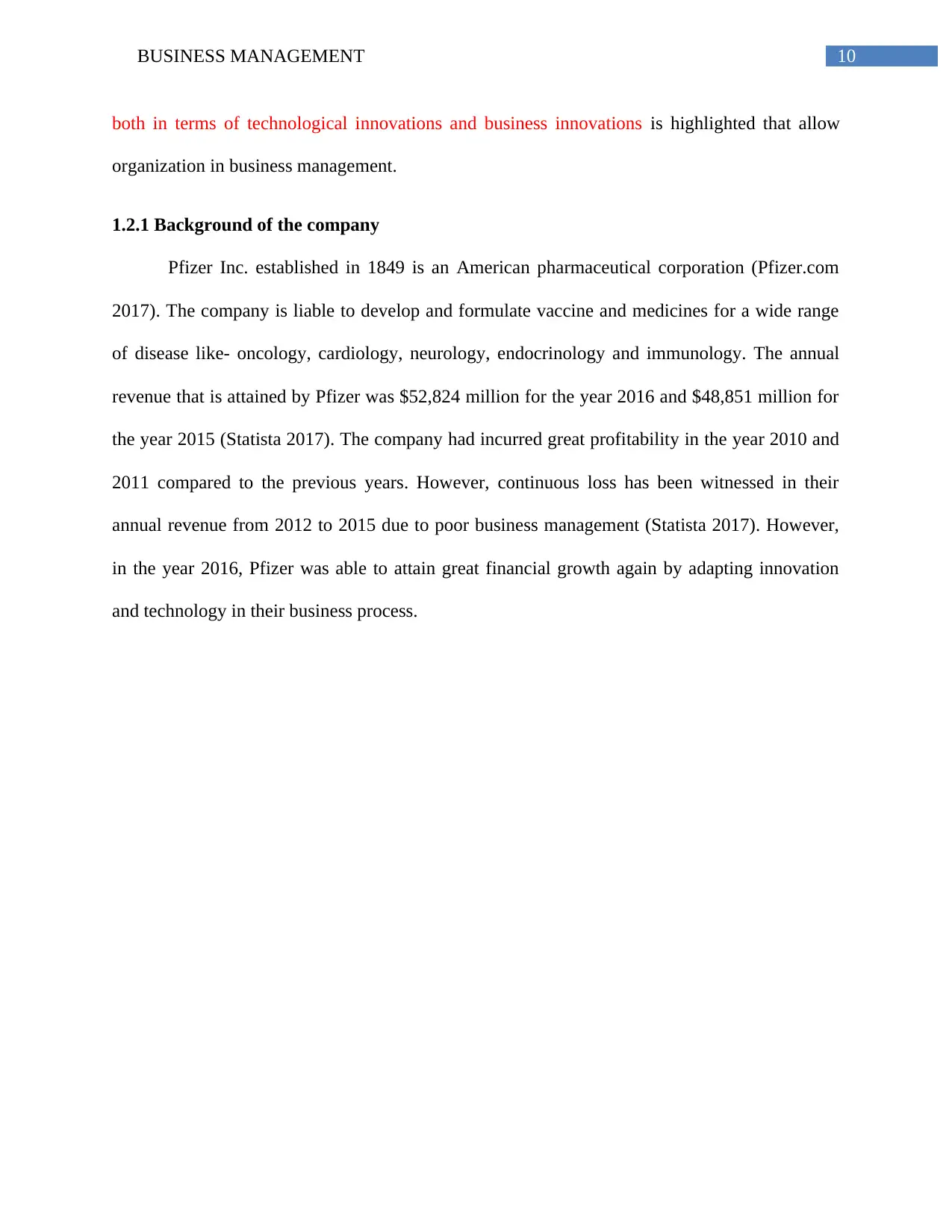
10BUSINESS MANAGEMENT
both in terms of technological innovations and business innovations is highlighted that allow
organization in business management.
1.2.1 Background of the company
Pfizer Inc. established in 1849 is an American pharmaceutical corporation (Pfizer.com
2017). The company is liable to develop and formulate vaccine and medicines for a wide range
of disease like- oncology, cardiology, neurology, endocrinology and immunology. The annual
revenue that is attained by Pfizer was $52,824 million for the year 2016 and $48,851 million for
the year 2015 (Statista 2017). The company had incurred great profitability in the year 2010 and
2011 compared to the previous years. However, continuous loss has been witnessed in their
annual revenue from 2012 to 2015 due to poor business management (Statista 2017). However,
in the year 2016, Pfizer was able to attain great financial growth again by adapting innovation
and technology in their business process.
both in terms of technological innovations and business innovations is highlighted that allow
organization in business management.
1.2.1 Background of the company
Pfizer Inc. established in 1849 is an American pharmaceutical corporation (Pfizer.com
2017). The company is liable to develop and formulate vaccine and medicines for a wide range
of disease like- oncology, cardiology, neurology, endocrinology and immunology. The annual
revenue that is attained by Pfizer was $52,824 million for the year 2016 and $48,851 million for
the year 2015 (Statista 2017). The company had incurred great profitability in the year 2010 and
2011 compared to the previous years. However, continuous loss has been witnessed in their
annual revenue from 2012 to 2015 due to poor business management (Statista 2017). However,
in the year 2016, Pfizer was able to attain great financial growth again by adapting innovation
and technology in their business process.
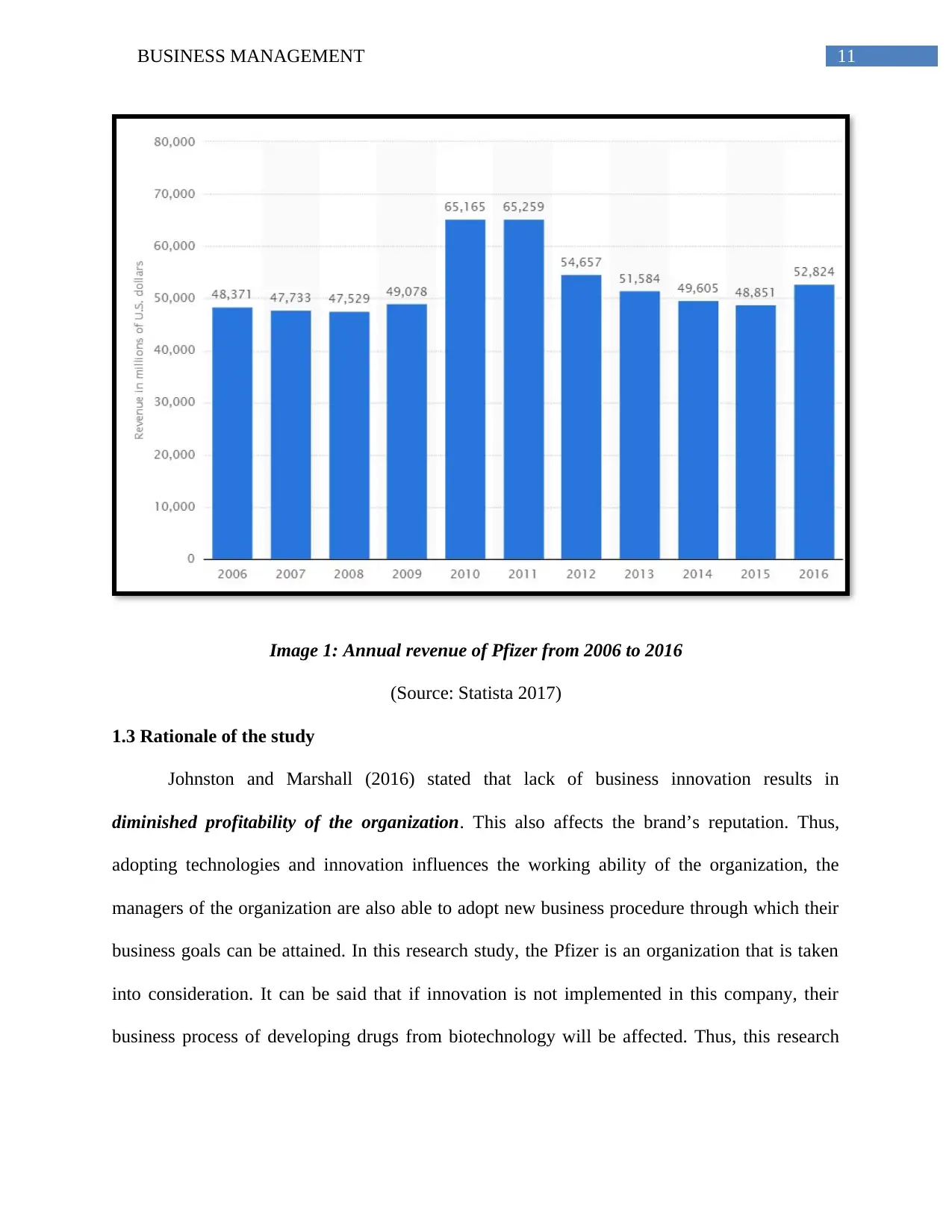
11BUSINESS MANAGEMENT
Image 1: Annual revenue of Pfizer from 2006 to 2016
(Source: Statista 2017)
1.3 Rationale of the study
Johnston and Marshall (2016) stated that lack of business innovation results in
diminished profitability of the organization. This also affects the brand’s reputation. Thus,
adopting technologies and innovation influences the working ability of the organization, the
managers of the organization are also able to adopt new business procedure through which their
business goals can be attained. In this research study, the Pfizer is an organization that is taken
into consideration. It can be said that if innovation is not implemented in this company, their
business process of developing drugs from biotechnology will be affected. Thus, this research
Image 1: Annual revenue of Pfizer from 2006 to 2016
(Source: Statista 2017)
1.3 Rationale of the study
Johnston and Marshall (2016) stated that lack of business innovation results in
diminished profitability of the organization. This also affects the brand’s reputation. Thus,
adopting technologies and innovation influences the working ability of the organization, the
managers of the organization are also able to adopt new business procedure through which their
business goals can be attained. In this research study, the Pfizer is an organization that is taken
into consideration. It can be said that if innovation is not implemented in this company, their
business process of developing drugs from biotechnology will be affected. Thus, this research
⊘ This is a preview!⊘
Do you want full access?
Subscribe today to unlock all pages.

Trusted by 1+ million students worldwide
1 out of 71
Related Documents
Your All-in-One AI-Powered Toolkit for Academic Success.
+13062052269
info@desklib.com
Available 24*7 on WhatsApp / Email
![[object Object]](/_next/static/media/star-bottom.7253800d.svg)
Unlock your academic potential
Copyright © 2020–2025 A2Z Services. All Rights Reserved. Developed and managed by ZUCOL.





